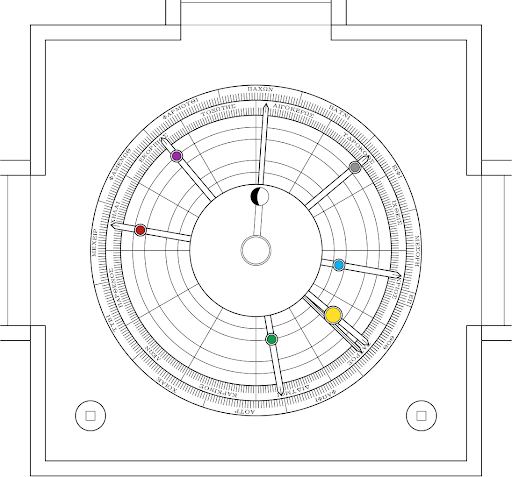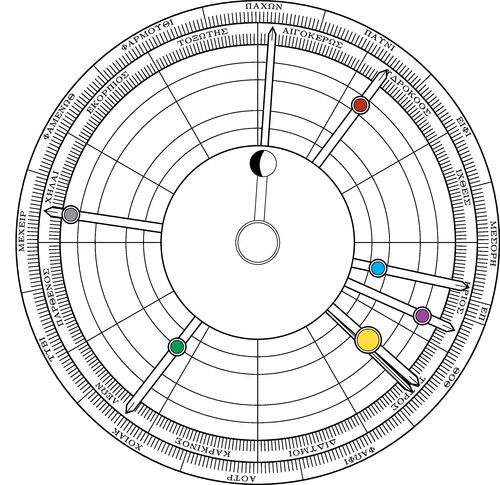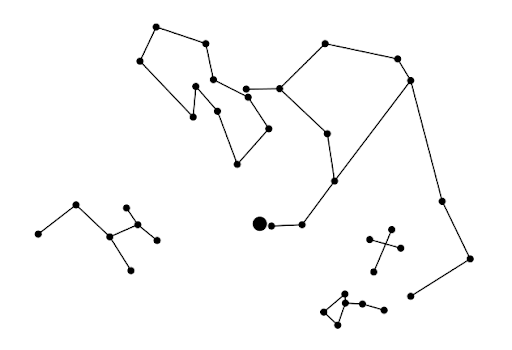The Guest Star Portends
A desert-themed astrological puzzle inspired by a 2000 year-old analog computer, an ancient supernova, and the Ziggurat of Ur.
Introduction
The Guest Star Portends is an astrological puzzle which requires a fair amount of 'real-world' problem solving. The premise is simple - an isolated temple with a strange piece of clockwork and a barred entryway with a cryptic message. This puzzle is challenging in that it doesn't have a straightforward ask-and-solve setup. The players must explore to reveal it, interact with the device to get a feel for its function and to begin reasoning about its purpose, and will likely have to leave the ziggurat to conduct research on its people and the strange things found there only to return later, better equipped to handle the challenge.
As the Dungeon Master, it is your role to understand the puzzle and guide the players in their discovery. The puzzle is fairly open-ended, so you should be ready to describe the reactions to turning the cranks and playing with the parts.
The players will be expected to initially act like any adventuring party, mindlessly charging into the great unknown expecting ghosts and goblins. Upon finding the ziggurat they may realize that they are dealing with something different - and perhaps most strikingly - strange problems that are altogether real-world. Make sure that they brought water. Make sure they brought rations. The desert can be unforgiving. Do they have some way to locate the ziggurat? Orienteering in the desert isn't easy. Did they bring shovels? Digging with swords and hands is tiring work. This puzzle requires knowledge that I don't currently have? Dang it, maybe I have to travel to a center of knowledge and look things up. Shoot, I need a metal rod now too? Back to town I go....
This puzzle shouldn't require solving math problems, but it should force the players to think.
Have fun!
Background
The Ziggurat of An is one of several structures lying buried in a remote corner of an arid wasteland in the southern hemisphere. The prevailing winds shift the dunes back and forth, sometimes releasing part of the limestone structure from their earthen grip, but mostly keeping them bedecked and unseen. The ruins were built by an ancient people over a thousand years ago, whose civilization has crumbled to dust, their way of life as forgotten and lost as the ruins themselves.
Perhaps the ziggurat contains an entire temple complex. Perhaps it is the burial tomb of an ancient ruler. Perhaps the players merely ended up here by chance. Whatever the case, your players' expedition has arrived at the site of the Ziggurat of An.
Relevant knowledge skill checks will tell you about the civilization: - they had advanced astrological scholars who tracked time via the stars - they used a 365-day calendar (Sothic cycle), syncing with the annual flooding - their language, and perhaps a bonus to deciphering their script - any additional information you, as the DM, would like to impart
The ziggurat is a four-sided structure, three of which contain broad ramps and a fourth flat face on the north side. It is made of large stone blocks which have withstood the passing of the ages with remarkable resilience, but are nevertheless smoothed and pitted from the desert winds.
At present the ziggurat is mostly covered in sand. Digging with swords and hands is possible but would take a long time. Excavation first uncovers the top surface of the ziggurat and the strange bronze mechanism that it bears. Further excavation, over the course of several days with a dedicated team, uncovers the ramps and the flat face. The above-ground portion of the ziggurat is ten feet high and the ramps each stretch fifteen feet laterally from the base. The flat face is revealed to contain a large indented bronze slab, perhaps some sort of blocked entryway.
Engravings can be found on the rock, particularly on the lower locations which have not seen as much punishment from the moving dunes. In some places there are still flecks of color, indicating that at one time the structure was, in whole or in part, covered in plaster and painted. Murals can be carefully excavated, depicting scenes of ritual - the daily turning of the mechanism wheel at the passage of a day, the turning of the outer rim once every four years to account for a leap-day, and various cultural uses for the mechanism in which the clock is turned forwards to predict eclipses and the alignments of various planets.
knowledge(astrology) - the front face perfectly aligned with the Pole Star knowledge(architecture) - the structure is made from cast agglomerated limestone concrete
NOTE: depending on your setting and the nature of your players, it may be wise to justify the resilience of the structure by some sort of latent magic. Sly players may suggest tunneling into the structure or merely cast stoneshape. Whether you want to allow for such solutions is up to you, but they will significantly detract from the mystery of the mechanism.
Top Surface
The top surface is a broad, flat square 15 ft on a side. It is ringed in a low, step-sized lip of stone blocks. Clearing off more sand reveals a curious bronze object in the center. Further removal reveals a circular hub-cap with long, bronze shafts much like the hands on a clock, mounted within a ten-foot diameter impression bordered by two concentric bronze rings.
profession(archaeology) - gain a bonus on sand removal to reduce jamming to the mechanism,
get an easier time setting the rings into motion.

Outer ring
The outer bronze ring is marked with straight ticks spaced at even intervals around its circumference, and is split into thirteen sections by larger ticks. These sections are labeled in the people's strange script.
search - there are 365 ticks on the outer wheel, and 365 days in the year
search - the ring appears to be move as part of its function on the mechanism
knowledge - deciphering the script gives you strange words.
These are the names of the 13 months that the people used.
knowledge(astronomy) - there are 13 months in their Sothic calendar, each with 30 days,
except Ep, which only has five days.
The true purpose of the outer ring is to keep track of the 365-day calendar. The long, thin hand points to the current day. The outer ring is movable such that it can be adjusted once every four years to account for leap-days.
Inner ring
The inner bronze ring is also marked with straight ticks spaced at even intervals around its circumference, and is split into twelve evenly-spaced sections. Each section is labeled in the people's strange script. Closer inspection finds that the inner ring is permanently fixed in place.
search - there are 360 ticks in total, and 12 sections each with 30 ticks decipher script ->the labels each correspond to signs of the zodiac knowledge(astronomy) - the zodiac signs are spread according to their locations in the sky
The true purpose of the inner ring is to mark out the 360 degrees of the heavens. The zodiac signs are useful when orienting oneself.
Arms
Eight bronze arms jut out of the central hub. There are five thicker arms bearing flat bronze circles inlaid with sheets semi-precious stones. The remaining two arms are thinner and unadorned. One is aligned with a half-black, half-white sphere on the hub of the device.
The true purpose of the arms is the track the motions of the moon, sun, five known planets, and the current day. The positions are all relative to the ecliptic (apparent orbit of the sun relative to the Earth).
- yellow - Sun
- blue - Mercury
- green - Venus
- red - Mars
- purple - Jupiter
- gray - Saturn
The thin arm with the line down its length points to the current day, indicated on the outer rim. The arm aligned with the black and white sphere indicates the position of the moon, whereas the sphere rotates to indicate the moon's phase.
Rotors
Clearing off all of the sand reveals two bronze circles mounted in the flagstones at the bottom of the square surface. They each contain square indentations about 4 inches wide and eight inches deep.
knowledge or search - the indentations are worn as though a square peg was placed within
The mechanism can be moved by placing square rods into the pegs and rotating them. The machine is quite rusted but overall is in surprisingly good condition. Perhaps some sort of magic has helped to protect it over the ages.
It takes great strength to get the machine to move. Oiling the exposed parts helps. The players will likely have to fashion rods with some sort of leverage-enabling components on them (wheels, giant cranks) themselves.
Western Rotor
Turning the western rotor causes the outer ring of the mechanism to turn. One complete rotation of the rotor causes the outer ring to shift by one tick-marking, or 1/356 degrees. This was done once every four years to account for leap-days.
Eastern Rotor
Turning the eastern rotor is much harder, as much more machinery must be set into motion. One complete rotation of the rotor causes the arms of the device to move and the black and white sphere to rotate (not shown below).
Repeated rotations of the rotor find that the unadorned pointers not aligned with the black and white sphere moves exactly one tick marking on the outer ring, 1/356 degrees, whereas the black and white sphere rotates roughly once every 28 turns and its pointer does likewise. The pointers with the circular attachments move more chaotically. They point to the location of the various planets relative to the Earth, and since each has an elliptical orbit the resulting motion is weird. This is best explained in the gif below.

The Bronze Gate
The northern face of the ziggurat requires a good deal of excavation. At long last the face is uncovered. The ziggurat is ten feet high from the top to the foundation.
The face contains a rectangular entryway blocked by a solid bronze gate. The gate appears to be quite sturdy, and is likely magically reinforced. Its surface is engraved with a point-and-line drawing, and contains a sequence of text (in their language, of course):
The Gates of Knowledge open at the arrival of the Guest Star

The guest star is a reference to Supernova 185, the first supernova in recorded history. It appeared in the southern hemisphere in the constellation of Circinus, remaining visible in the sky for around eight months. The drawing on the gate shows the constellations Lupus (Wolf), Centaurus (Centaur), Ara (Altar), Musca (Fly), and Crux (Cross). (These were all known constellations to the ancient Greeks.)
Those conducting research into the Guest Star may obtain the following text from the 'Book of Later Han':
On the fifth day in the tenth month
of the second year of Ur's reign,
a guest star appeared within Circinus;
it was as big as half a mat;
it was multicolored and it fluctuated.
It gradually became smaller and disappeared
in the sixth month of the year following the next year.
According to the standard prognostication this means insurrection.
The meaning behind the message on the Gates of Knowledge and the engraving is that the gates only unlock when the mechanism is set to the same date as the first viewing of the Guest Star. Knowing this, the players must:
- Determine the present date relative to the Sothic cycle (marked on outer rim)
- Adjust the outer rim of the mechanism to reflect the present date
- Adjust the mechanism to the present date such that it points to the current position of the Sun, Moon, and planets. This could take more than a thousand turns if the mechanism hasn't been run in a while
- Determine when the date the fifth day of the tenth month of the second year of Ur's reign was relative to the present
- Adjust the outer rim by the number of leap-days over said period
- Turn the mechanism back in time to the date of the supernova's sighting
Note that other solutions exist, and clever players will always surprise you. Direct enumeration is probably not going to work, as the mechanism's repetition period is enormous.
Setting the mechanism to the correct state causes a mechanical thunk to be heard, and the slow release of some internal weight and shifting clockwork causes the bolts from the gate to be retracted. The party can now push the gate in and venture into the ziggurat.
Who knows what they will find!
References
The mechanism is the Antikythera mechanism, a clockwork device dating from 200 BCE found in a Greek shipwreck. It exhibits extreme complexity and elegant workmanship, being able to track the position of all five known planets, the sun, the moon (including phase), and the current date. It had an entire back panel too (not included in this puzzle) that tracked other calendars, including the occurence of the Olympic games.
The Ziggurat of Ur is a temple in Iraq. The original is much larger than what I imagine for this puzzle, and doesn't include a flat face with a bronze door (nor a mechanism on top). Nevertheless, it reflects the style of architecture I envision and invokes a sense of desert mystique.
Lastly, this puzzle was inspired by SN 185, the oldest supernova in recorded history. I talk about that earlier in this post.
LaTeX Source
Here is are the source files for the Antikythera mechanism and for the constellation engraving, respectively. The first one must be compiled using lualatex. The second works fine with pdflatex as well.
lualatex disk.tex
Not Registered Yet? No problem.
Do you want Strolenati super powers? Registering. That's how you get super powers! These are just a couple powers you receive with more to come as you participate.
- Upvote and give XP to encourage useful comments.
- Work on submissions in private or flag them for assistance.
- Earn XP and gain levels that give you more site abilities (super powers).
- You should register. All your friends are doing it!
? Responses (10)
Upset Barbarian Horde can be (slightly) less upset
Ok, this is the type of post and puzzle I love. I can't ask for anything more on this - this is truly great stuff!
Awesome!
So stoked! Thank you.
Update: Added LaTeX source files for the graphics.
This is perfect.
Aside from the puzzle, awesome use of real-world references and inspiration, clever lore, constellations, amazing graphics...
Love it!!
This made my head hurt... but damn is it detailed and complete. golf clap and kudos on this one.
Love this idea. With some adaption I would use it in Star Frontiers- Tetrarch Pyramid on Laco
Thanks! It can certainly be adapted.
Re-uploaded images. Apparently they had been lost.
